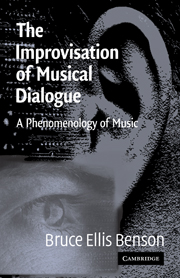THREE - Performing: The Improvisation of Preservation
Published online by Cambridge University Press: 14 January 2010
Summary
While we have seen that the activity of composing takes place within the framework of a musical discourse or practice, we have concentrated largely on the composer's part of that process. Yet, at least in the discourse of classical music (and even, say, in the composition of jazz tunes), there usually comes a point at which a piece of music takes on written form that gives it a relatively permanent existence, one that often extends far beyond the composer's own existence. But does writing serve only to preserve a musical work? What we will see is that making a piece of music publicly available by means of a written score results in both preservation and improvisation. And this improvisation affects the very identity of the musical composition.
Unbestimmtheitsstellen and the Irrelevanzsphäre
We tend to think of language as a kind of conductor through which thoughts are able to travel from one person to another. Writing takes this a step further, for it provides a lasting link to others in the form of an inscription. Thus, a score – written in a kind of musical language – does not simply provide a way of “remembering” a musical work. It also gives the work a kind of ideal existence, for it takes on a more or less “defined” form and so can be passed on to others.
- Type
- Chapter
- Information
- The Improvisation of Musical DialogueA Phenomenology of Music, pp. 77 - 124Publisher: Cambridge University PressPrint publication year: 2003



